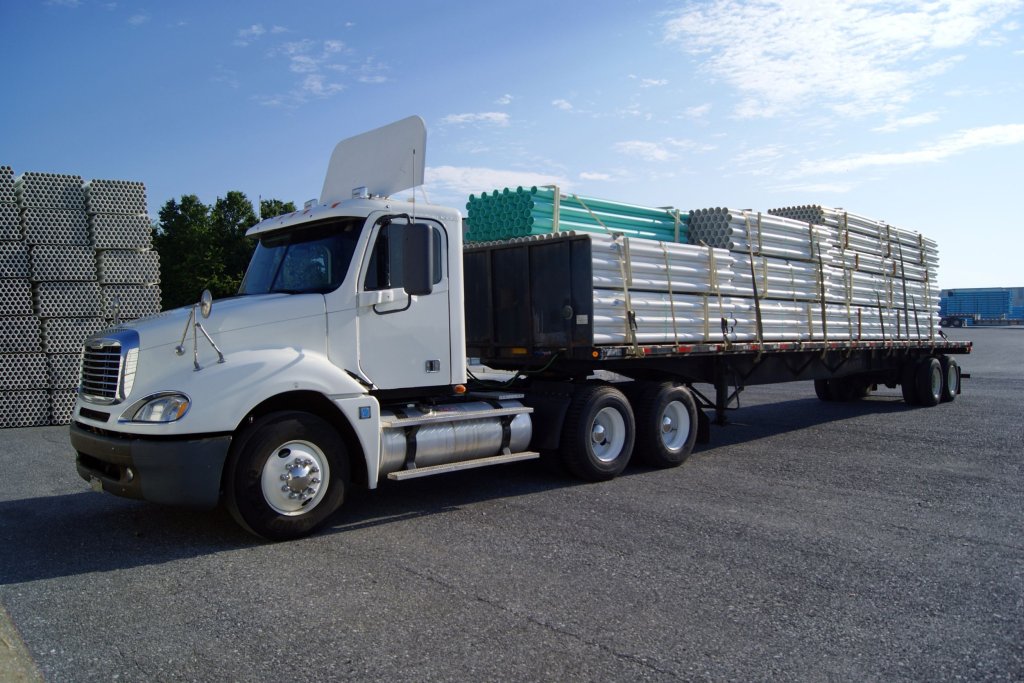As a truck driver, there are a number of types of jobs to consider. Most trucking jobs involve hauling a standard-sized load in an enclosed trailer. With flatbed trucking, you can take on oversized or irregularly shaped loads.
Since there is the added responsibility of securing the load yourself, these jobs offer a new experience. So, if you’re looking for something new, flatbed trucking could be for you.
Keep reading if you’re interested in knowing what a flatbed driving job entails and the benefits of this type of job.
If you’re interested in a flatbed trucking job, we’ll offer some insight on how to find one.
What is Flatbed Trucking?
Flatbed trucks entail carrying loads on a flat, open trailer. This offers greater flexibility for hauling specialized freight. When carrying large or oddly shaped cargo on a flatbed truck, it’s your job to properly secure the load with chains, straps, or a tarp. This requires knowledge of weight distribution and safety precautions necessary to prevent accidents or damage to the cargo.
The difference in flatbed loads makes them more challenging and interesting than standard dry van trailers. Since they require specific skills, there are added benefits to taking on flatbed work. You’ll be able to get paid more and experience new routes.
Types of Flatbed Trailers
One of the new things you’ll experience with flatbed trucking is a whole new variety of trailer types that vary from a standard dry van. These trailers come in all shapes and sizes to help with different loads or make loading easier.
Here are some of the trailer types you may encounter:
Standard Open Deck
The standard open deck is the most common type of trailer. It’s completely flat and level with no sides or roof. This can come in handy for any kind of load, regardless of its size or shape, which is why it’s used most often.
Step Deck Trailer
Step deck trucking jobs entail carrying items that are taller. So, this trailer type has a “drop” in deck height to accommodate something higher. This feature is why they’re also known as drop-deck trailers.
If the freight doesn’t fit on the standard trailer or the drop deck, a double-drop deck can help. It has a lower deck in the middle with two higher decks on either end. This is especially useful for loads that are over-height.
Extendable Open Deck
An extendable open deck is designed for longer loads. It provides additional support and prevents the risk of overhang, which ensures that nothing falls off during transport. The added support makes the transportation of longer loads much smoother.
Removable Gooseneck Trailer
A removable gooseneck trailer has a removable front end that allows the trailer to drop down and become a ramp. This makes loading and unloading a heavy haul much easier. As the one responsible for this process, this type of trailer is especially beneficial for you.
Lowboy Trailer
This type of trailer is made to sit extremely low to the ground, which is ideal for hauling oversized or tall items. Once again, this can make loading and unloading easier for you.
Conestoga Flatbed Trailer
A Conestoga flatbed trailer has a flexible rolling tarp system that can be used to cover freight. This provides shelter from the elements and makes the tarping process easier. It’s perfect for transportation in inclement weather without sacrificing loading flexibility.
Benefits of Flatbed Trucking
With flatbed freight, you take on loads of machinery and construction materials that wouldn’t fit in an enclosed trailer. A flatbed truck driver must have a different skill set to handle such a load. This means you’ll be amply paid for such skills.
Here are just some of the benefits of being a flatbed driver:
Higher Pay Rates

The greater the risk, the greater the reward when it comes to heavy cargo. As a flatbed truck driver, you’ll carry construction materials like lumber and heavy machinery that can be dangerous. This will demand greater precaution as well. The more effort you put into it, the more you can get out of it.
Since flatbed truck drivers need to have a broader set of skills, this will be reflected in the pay scale. This job entails more physical labor and greater responsibility, so it also offers higher pay.
More Physical Activity

Flatbed truck drivers take part in the manual loading and unloading of their cargo, which means more physical activity. In addition, due to securement devices such as chains, there is even more room to flex your muscles.
Loads like these must be regularly inspected. This requires the drivers to climb on and off the truck frequently, adding even more opportunities to get up and moving.
Sitting for long periods can be difficult, so flatbed trucking offers more room to get up and stretch.
The Thrill and Challenge of Handling Oversized Cargo

Handling oversized loads can be challenging but also thrilling. Flatbed trucking opens you up to a whole new skill set, such as securing the load, tarping, transporting the load, and unloading cargo. This new expertise allows drivers to add to their list of abilities that appeal to a trucking company.
Additionally, oversized loads present unexpected obstacles that offer you to advance your problem-solving skills. These loads also require drivers to carry cargo down different, more challenging routes than normal. This means that there will be new paths for you to explore.
Flatbed truck driving jobs offer a greater variety than standard jobs. So, it’s a new adventure every time you set off with a flatbed trailer.
Requirements for a Flatbed Truck Driver
As you know, flatbed hauling is different from standard truck driving jobs. With more risk, more tasks, and more physical activity, there is a lot more that you’ll need to become a flatbed truck driver.
Drivers must meet the unique requirements to succeed in the job. Here, we’ll outline some of those requirements.
Understanding Load Securement Procedures

So, you already know that you’re responsible for securing the load, but you may be wondering what that entails. There are a few procedures you must go through to keep everything properly loaded.
First, ensure that the load is balanced so that no cargo shifts or the load doesn’t tip during transport. Then, you’ll want to inspect the equipment, such as the chains and straps, to check for any wear or damage that would compromise the safety of the load.
Once you feel confident everything is properly loaded, use the equipment to tie everything down. You can use corner protectors for loads with sharp edges.
In the case of inclement weather or for protection against road debris during transit, tarps may be used. Tarping is the responsibility of the driver, and it entails securing the tarp with bungee cords or ropes so that it doesn’t come loose.
Tarps come in various sizes, so choosing one that fits the equipment is important. You’ll be using tarps through many different elements, so you’ll also need to inspect for any holes or damage.
After you start hauling the cargo, perform frequent checks so that if any shifting or loosening occurs, you can re-secure it.
Flatbed drivers haul specialized freight. You’ll want to be properly trained on securing freight to flatbed trailers because understanding how to do so guarantees that the cargo arrives in good condition.
Familiarizing Yourself With Safety Regulations

The most important thing truck drivers should do is follow safety regulations. If you’re not driving safely, you can’t guarantee that your loads will be safe. Drivers should follow a few strict rules to adhere to these regulations.
First, you should always ensure that everything is properly secured. As always, flatbed truck drivers must follow the speed limit. If they don’t, drivers risk losing control of the freight or causing an accident.
Since flatbed trailers face an increased risk of instability and accidents, it’s important that drivers follow weight limits. To remain safe, flatbed trucks should always have flags and lights that signal to another vehicle that they’re oversized.
Flatbed drivers should also follow the same procedures as most drivers. This means that trucks should be regularly inspected to make sure they’re running smoothly. In addition, drivers must remain focused on the road during transport and avoid using mobile devices.
Finally, pay attention to the weather conditions. If you operate a flatbed trailer, be sure to reduce your speed or pull over when needed.
How to Find Flatbed Trucking Jobs
Whether you have prior flatbed trucking experience or not, you can still become a flatbed driver. All that flatbed drivers need is their Class A CDL.
If you’re interested in a flatbed trucking job but don’t know where to start, AllTruckJobs.com sorts jobs by freight type, so you can easily find what you’re looking for.
Why Consider Flatbed Trucking?
If you don’t feel challenged in your current job or you’re looking for higher pay, look into becoming a flatbed driver. With flatbed trucks, you’ll gain new experience hauling freight, securing loads, and traversing new terrain.
Flatbed truck drivers have more opportunities to break up the monotony you face with standard truck driving, and you can get paid more while doing it. There’s nothing better than that.

November 12, 2019
It makes sense that flatbed trucks require you to understand how to properly use a tarp to secure your loads. My uncle has recently invested in a flatbed truck that he would like to use to open a moving service, but he needs to learn how to keep heavy objects secure to prevent liabilities. Maybe he should find some tarps that are specifically made for flatbed trucks.
November 12, 2019
Yeah, for sure! A quick Google search will show you that there are lots of brands selling tarps for flatbeds.
February 29, 2020
all tarps are the same basically. You have to make them fit on each piece. No one can show you that
March 27, 2020
Tarps just cover the freight. Doesnt hold it down. You get chains, binders and straps for that
April 5, 2020
I hope he realizes that tarping a load is not a way to secure it
December 7, 2019
As a flatbedder of 15 years I will advise that if you tend to be in a hurry, lazy, or think you know everything you dont want to be in flatbeds. What you put on your back WILL try its hardest to come off thst deck. In the last few years I’ve seen people in this business doing the dumbest crap all because they are in a hurry and just dont care.. Our families are on these roads too. Killing someone is very easy in a flatbed. If you hate messing with loadlocks you need to stay out of flatbeds.
September 18, 2020
Skateboarding is a Serious job… no games allowed here.. detail and making sure you load is secure is Very Important.. and its all Hands on!!!!! 14 yrs deep myself
December 14, 2019
I just recently joined the flatbed fraternity. And, last night I did my 1st tarp load. That I had to actually do myself in the cold rain & at night. The load I had b4 it was already tarpped. So, when I dropped off that load. I apparently didn’t roll up the tarps right. Cause, when I went to tarp the load last night it was all backwards!!! LOL!! So, I had to turn around the flap tarp on the bed, while it was pouring rain & in the dark. Besides my utility lights on the back of my tractor. There wasn’t a tarpping lesson, because only 10% of our loads require tarps. And, my luck, I get part of that 10% on my 1st route. Mind u I’ve been trucking for 22 years. But, just swinging doors. However, I corrected the mistake and got it tight as possible on the load/bed. I’ve always wanted to do flatbed trucking. Cause, the pay is better, depending who u pull for, & the physical aspect of it. As with pulling a box ur not out using ur body too much, if stall, so one can tend to get outta shape quick. I would like to get my own tractor & become an O/O pulling flatbed. So, that’s another reason why. I’ve heard O/O’s make a REAL GOOD living pulling heavy haul & OD. If anyone has any suggestions or advice I’m more than open to them. Thanx
November 25, 2020
Cash out lay is a lot more when you haul oversized loads. Escort, permits, routing and empty miles to acquire the load. So your$20 a mile load has just dropped to $11. A lot to consider here.
February 22, 2020
I like what these guys was saying, as being a female the reason is some what different, I chose Flatbed because I was burn out on Box,.Refer,let say any thing look like a box, so this was more as a challenge, yes the trap is something, but I still love the job, I hope more women consider doing this type of work, Women you still can be feminine doing this type of work, smile, I still and always love my Mens, I just love Flatbed.
July 25, 2020
Any tips you could give me [email protected]
November 7, 2020
Hi Bessie,, I started driving a Conestoga trailer, flatbed with a curtain, last year. I haul aluminum as a dedicated regional driver…It’s very challenging.
November 25, 2020
You might like the idea of hauling oversized loads but bare in mind with specialized you’ll have a larger % of deadhead miles. Make sure to read your permit as you can get in great trouble if you don’t.
March 3, 2020
It is wonderful that you pointed out that there is a set of necessary skills needed for flatbed trucking, such as tarping skills. My brother mentioned that he wanted to hire a flatbed trucking provider to help with his construction work. I will advise him to ask about the driver’s experience and knowledge in flatbed trucking.
April 5, 2020
Oversize loads are where the money is at some of them. As much as $20 a mile
June 27, 2020
I got into flatbeding 6yrs ago and loved it.I worked in the rain the het and heavy snow i hated rolling tarps in the snow it was a challenge same with the wind.crawling around ontop of a load trying to tarp wow.the pay Wasn’t bad i gor out do to the fact i had a hernia and bad shoulders. With months of therapists im considering retuning at some point.
August 1, 2020
Got out of flatbed due to a company going under and went to car hauling. I miss flatbed even though the money in car hauling is great. The strapping and chaining was alot of fun. Every day was different and that was good
August 30, 2020
My name is Jenice Turner aka Coolaid and I work at P&S Transportation and they will teach you how to Flatbed the right way. Don’t forget to mention me😍🙏 B.C.B.S, After taxes I take home 18K a week. Anything more than that u will have to live in your truck.
February 13, 2021
We don’t use the tarps to secure the load. Tapping is independent of securement. The regulations are pretty simple. I put 2 straps per object. If longer than 8ft I begin to use more. Steel coils I use 4 chains minimum under 40k weight. 6 chains minimum for anything over 40 to 56k.